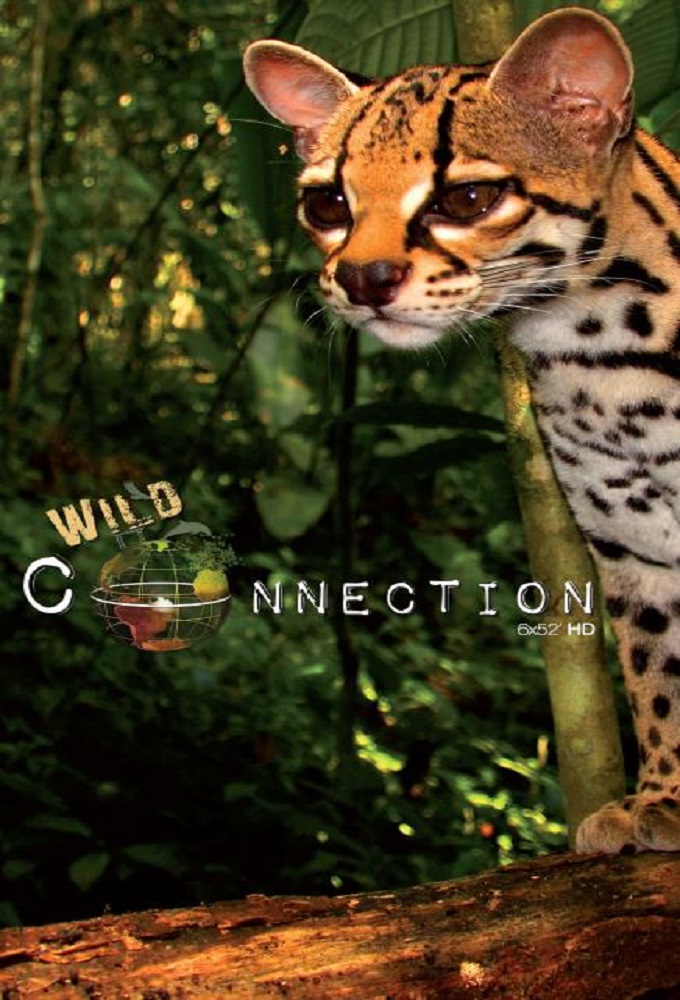
Wild Connection
Non notée
Année : 2011
Nombre de saisons : 1
Durée moyenne d'un épisode : 45 minutes
Genre(s) : Documentaire
This series uncovers the astonishing similarities and sharp differences between two of earth’s richest meeting points between continents – bridges where vastly different animal populations intermingle during their eternal quest for survival. These geographical bridges between huge land masses create unique places where the flora and fauna of two continents intermingle. The narrow strip of land connecting the continents of the Americas is an authentic Noah´s ark with huge number of species, all of them coming from south and north and making their home Central America, a geological newcomer, when compared to the age of the land masses north and south. Africa and Europe are separated by the narrowest of sea passages at Gibralter and a the border territory of the Iberian penisula. This region features the richest biodiversity in Europe, with its umbilical cord to the African continent. Through the series, we encounter species at their best, from intimate situations, to predation and action scenes. Spectacular blue chip filming provides evidence from the field while graphics will help to understand the geological process that shaped these two areas of our planet, and how the species colonize them. Six episodes that will immerse us in the vastness life exuberance of these unique places on earth. A series that conclusively proves that diversity blooms whenever its given a fighting chance. http://www.u7tv.ru/eng/index.shtml?sectionid=003&progid=0272
Saisons

Saison 1
Épisodes
Choisissez votre saison au dessus et découvrez les épisodes qui vous attendent !
Épisode 1 - The Great Bridge
6 février 2011
With the geological closure of the Isthmus of Panama 4 million years ago, the two largest oceans of the planet were separated, causing their respective marine populations to become divided. Central America was gradually formed by the intense volcanic activity of the area, and began to be colonized by plants, birds and bats capable of invading every new island in construction. The highest mountains in Central America, some unique ecological conditions and the erosion produced by violent tropical storms finally gave shape to the "Great Bridge" uniting the Americas. Across the bridge, the journey of thousands of pioneering species begins.
Épisode 2 - Tracks in the Jungle
Central America is witness to the collision between two worlds. It is here where the first encounter between the North and the South took place. For millions of years, South America and North America were two huge and independent islands, each with their own wildlife. This area still maintains the largest old-growth forests of the American Pacific. In these forests, situated in the southern region, several species of animals began to cohabitate: those coming from the North (predators such as the jaguar or herbivores such as the tapir) and those coming from the South (most monkey species).
Épisode 3 - Nature's Erector Set
Paradise is a narrow, long and mountainous hallway. This is where hundreds of thousands of species of plants and animalslive. The umbilical cord that linked the two continents caused casualties, but it also created the richest and most diverse colonies. The Caribbean rainforests are the home to magnificent and lonely Quetzal males, which display their plumage in the privacy of heights, while amazing amphibians feed themselves on the forest's ground. The Pacific coast is witness to one of the most beautiful and hardest spectacles of nature: the egg-laying season of thousands of turtles and the feast some other animals make of it.
Épisode 4 - The Old World Connection
This episode takes us to a new zone in the planet. It explores the formation of the Iberian Peninsula and its influence on the limiting of continents, introducing representative areas and ecosystems that will be explored in the following episodes. The Iberian Peninsula used to be a small continent floating on a plate between Africa and Europe. The Alpine orogeny strategically caused the peninsula to collide with the southern European continent, giving shape and almost closing the Mediterranean Sea. As a result of that movement, both continents became closer and numerous mountain chains, such as the Pyrenees, the Central System and the "Picos de Europa", were formed. The peninsula became a bridge full of distinctive features and ecosystems that facilitated the existence of diverse and unique landscapes. On the one hand, the mountainous North was filled with wet and cold Euro-Siberian forests. On the other, the South turned into a warm territory where several species found shelter during the ice age.
Épisode 5 - Forests between Two Worlds
Summer and winter share the Iberian Peninsula's territory: a place influenced by the humid and cold northern weather, but also by the Mediterranean heat and sun. This land connection favours the development of highly diverse forests, shaped by varied and opposing weather conditions. While some forests are originated in boreal lands and extend up to Siberia, others are adapted to the warm and dry weather, spreading across North Africa and a large part of the Mediterranean. The Peninsula's forests reflect its natural beauty. On the Iberian map, boreal forests flourish in the North, growing on mountains and seeking the cold dampness of the Atlantic Ocean. The warm Mediterranean weather pervades every corner of the Peninsula, leaving its trace all over the territory, and forming unique forests, where trees and animals have learned to endure extreme temperatures.
Épisode 6 - The Mediterranean Puzzle
The fact that Peninsula is located only fourteen kilometres away from Africa allows for the flow of species between the two continents, contributing to the enrichment of its fauna. The natural mix was finished with the oresence of man and the influence of the most diverse cultures that deeply transformed the landscape. During the summer, eagles, vultures,storks and passerriformes fly from Africa to Europe. Some species only make it to the peninsula, without crossing the barrier of the Pyrenees. It is their breeding territory. Other African travellers begin to conquer our continent little by little: the back-winged kite,the genet,the Egyptian mongoose or the chameleon. This episode explores the most amazing fauna of the peninsular connection, as well as the most peculiar ecosystems: dry plains, southern mountains and valleys carpeted with Mediterranean bushes.
Vidéos
Oups aucune vidéo pour le moment... Revenez plus tard pour des aventures en images !

Aucun avis pour le momment...